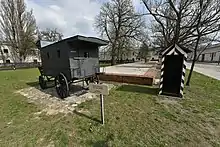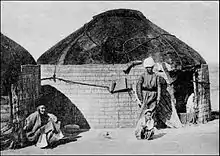Kibitka
A kibitka (Russian: Кибитка from the Arabic "Kubbat" - dome) is a pastoralist yurt of late 19th century Kyrgyz and Kazakh nomads.[1]

Aleksander Orlowski, "Traveler in a kibitka"

19th-century prison van known in Polish as kibitka

Kibitka of Teke people
The word also refers to a Russian type of carriage.[2] The kibitka uses the same equipage as the troika but, unlike the troika, is larger and usually closed. In Russian literature and folklore, kibitka is a term used mainly for Gypsy wagons. During the Russian Empire, its use to deport disgraced noblemen led to the term kibitkenjustiz ("kibitka justice").
See also
Sources
- "Toponymy of the Ancient Sary-Arka (North-Eastern Kazakhstan)".
- Kibitka Meyers Großes Konversations-Lexikon, vol. 10, Leipzig 1907, p. 880, in German.
This article is issued from Wikipedia. The text is licensed under Creative Commons - Attribution - Sharealike. Additional terms may apply for the media files.
